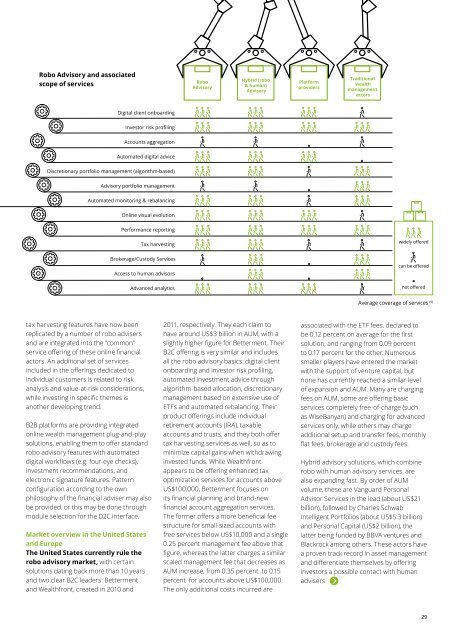lu_inside12-full
Create successful ePaper yourself
Turn your PDF publications into a flip-book with our unique Google optimized e-Paper software.
Robo Advisory and associated<br />
scope of services<br />
Robo<br />
Advisory<br />
Hybrid (robo<br />
& human)<br />
Advisory<br />
Platform<br />
providers<br />
Traditional<br />
wealth<br />
management<br />
actors<br />
Digital client onboarding<br />
Investor risk profiling<br />
Accounts aggregation<br />
Automated digital advice<br />
Discretionary portfolio management (algorithm-based)<br />
Advisory portfolio management<br />
Automated monitoring & rebalancing<br />
Online visual evo<strong>lu</strong>tion<br />
Performance reporting<br />
Tax harvesting<br />
widely offered<br />
Brokerage/Custody Services<br />
Access to human advisors<br />
Advanced analytics<br />
can be offered<br />
not offered<br />
Average coverage of services (6)<br />
tax harvesting features have now been<br />
replicated by a number of robo advisers<br />
and are integrated into the “common”<br />
service offering of these online financial<br />
actors. An additional set of services<br />
inc<strong>lu</strong>ded in the offerings dedicated to<br />
individual customers is related to risk<br />
analysis and va<strong>lu</strong>e-at-risk considerations,<br />
while investing in specific themes is<br />
another developing trend.<br />
B2B platforms are providing integrated<br />
online wealth management p<strong>lu</strong>g-and-play<br />
so<strong>lu</strong>tions, enabling them to offer standard<br />
robo advisory features with automated<br />
digital workflows (e.g. four-eye checks),<br />
investment recommendations, and<br />
electronic signature features. Pattern<br />
configuration according to the own<br />
philosophy of the financial adviser may also<br />
be provided, or this may be done through<br />
module selection for the D2C interface.<br />
Market overview in the United States<br />
and Europe<br />
The United States currently rule the<br />
robo advisory market, with certain<br />
so<strong>lu</strong>tions dating back more than 10 years<br />
and two clear B2C leaders: Betterment<br />
and Wealthfront, created in 2010 and<br />
2011, respectively. They each claim to<br />
have around US$3 billion in AUM, with a<br />
slightly higher figure for Betterment. Their<br />
B2C offering is very similar and inc<strong>lu</strong>des<br />
all the robo advisory basics: digital client<br />
onboarding and investor risk profiling,<br />
automated investment advice through<br />
algorithm-based allocation, discretionary<br />
management based on extensive use of<br />
ETFs and automated rebalancing. Their<br />
product offerings inc<strong>lu</strong>de individual<br />
retirement accounts (IRA), taxable<br />
accounts and trusts, and they both offer<br />
tax harvesting services as well, so as to<br />
minimize capital gains when withdrawing<br />
invested funds. While Wealthfront<br />
appears to be offering enhanced tax<br />
optimization services for accounts above<br />
US$100,000, Betterment focuses on<br />
its financial planning and brand-new<br />
financial account aggregation services.<br />
The former offers a more beneficial fee<br />
structure for small-sized accounts with<br />
free services below US$10,000 and a single<br />
0.25 percent management fee above that<br />
figure, whereas the latter charges a similar<br />
scaled management fee that decreases as<br />
AUM increase, from 0.35 percent to 0.15<br />
percent for accounts above US$100,000.<br />
The only additional costs incurred are<br />
associated with the ETF fees, declared to<br />
be 0.12 percent on average for the first<br />
so<strong>lu</strong>tion, and ranging from 0.09 percent<br />
to 0.17 percent for the other. Numerous<br />
smaller players have entered the market<br />
with the support of venture capital, but<br />
none has currently reached a similar level<br />
of expansion and AUM. Many are charging<br />
fees on AUM, some are offering basic<br />
services completely free-of-charge (such<br />
as WiseBanyan) and charging for advanced<br />
services only, while others may charge<br />
additional setup and transfer fees, monthly<br />
flat fees, brokerage and custody fees.<br />
Hybrid advisory so<strong>lu</strong>tions, which combine<br />
robo with human advisory services, are<br />
also expanding fast. By order of AUM<br />
vo<strong>lu</strong>me, these are Vanguard Personal<br />
Advisor Services in the lead (about US$21<br />
billion), followed by Charles Schwab<br />
Intelligent Portfolios (about US$5.3 billion)<br />
and Personal Capital (US$2 billion), the<br />
latter being funded by BBVA ventures and<br />
Blackrock among others. These actors have<br />
a proven track record in asset management<br />
and differentiate themselves by offering<br />
investors a possible contact with human<br />
advisers.<br />
29


